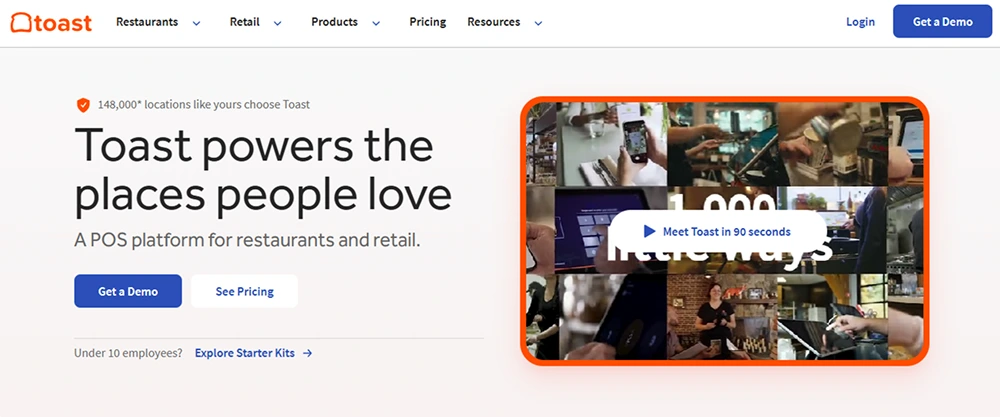Toast (Restaurants) Overview & 2025 Industry Position
Founded to modernize hospitality operations, Toast (Restaurants) provides an all-in-one platform that streamlines front-of-house, back-of-house, and guest engagement functions. In 2025, the brand holds a formidable position in the restaurant technology ecosystem, supporting everything from fine dining to fast casual. Its POS system—deeply integrated with payments, payroll, and inventory—addresses critical operational blind spots while enhancing customer experiences. With the shift toward automation, unified data platforms, and lower labor-to-revenue ratios, Toast (Restaurants) uniquely meets the moment with a purpose-built tech stack.
From Launch to 2025: Toast (Restaurants)’s Journey
Toast (Restaurants) launched in 2013, initially focused on cloud-based POS for restaurants. Its evolution includes a pivot toward full-suite management and verticalized fintech services. Key inflection points include:
- 2015: Launch of integrated online ordering and delivery
- 2017: Toast Go handheld POS released
- 2018: $115M Series D raised for expansion and R&D
- 2020: Rapid deployment of contactless dining and curbside tools
- 2021: IPO on NYSE, adding public confidence
- 2023: Launch of Toast Payroll & Team Management
In 2025, Toast (Restaurants)’s strategy revolves around consolidating restaurant SaaS and embedded financial tools in a single platform to drive loyalty, efficiency, and compliance.

Toast (Restaurants) Key Features
Toast (Restaurants) brings robust functionality across restaurant operations. Signature features in 2025 include:
- Flexible POS: Customize payment, menus, and ordering across table, counter, and kiosk setups.
- Handheld Solutions: Faster table turnaround with Toast Go 2 mobile POS.
- Online Ordering & Delivery: Commission-free ordering pages and multi-service delivery integrations.
- Toast Payroll & HR: Time tracking, wage calculation, and benefits embedding.
- Digital Kiosks: Improve order accuracy, increase spend.
- Marketing & Loyalty: Built-in campaigns, discounts, and loyalty integrations.
- Inventory Management: Real-time sync with purchasing and usage analytics.
Workflow & UX
The user flow in Toast (Restaurants) reflects the needs of dynamic, high-volume restaurant environments. Its interface stands out for:
- Minimal setup: Streamlined onboarding with intuitive templates
- Highly visual dashboards: Configurable for employees or management
- One-tap ordering and tipping: Time-saving interactions for staff and guests
- Mobile-first controls: Full POS and reporting from tablet or phone
Toast’s interface focuses squarely on reducing friction—for everyone from booked-out servers to shift-managing GMs.
Toast (Restaurants) Pricing Analysis & Value Metrics
As of July 2025, Toast (Restaurants) follows a modular pricing structure with the following tiers:
| Plan | Monthly Fee | Includes |
|---|---|---|
| Starter Kit | $0 + processing fees | POS, menu setup, digital ordering |
| Essentials | From $69 | POS, hand-held support, payroll, reporting |
| Custom | Quote-based | Advanced hardware/software, multi-location support |
Value Verdict: From micro-locations to regional brands, Toast (Restaurants) offers scalable returns against comprehensive operational coverage—especially when bundled with fintech features.
Toast (Restaurants) stands out within a dense POS and restaurant SaaS market. Key competitors include:
| Brand | Strength | Toast Advantage |
|---|---|---|
| Square for Restaurants | Affordable for startups | More scalable enterprise tooling |
| Clover | Hardware variety | Richer, foodservice-focused UX |
| Revel Systems | Multi-location deployment | Easier onboarding & UI |
| TouchBistro | User-friendly front-of-house | Integrated payroll and delivery hub |
Notable Use Cases
- Quick service restaurants using Toast Kiosks for faster lines
- Full-service dining with handhelds for tableside ordering
- Coffee shops using fast-to-ring POS for high-volume mornings
- Multi-location chains unifying payroll, sales, and labor data
Integrations & Ecosystem Benefits
Toast (Restaurants) supports dozens of third-party tools across marketing, logistics, and staffing categories:
- Payments: Stripe, Square compatibility for non-native setups
- HR & Payroll: Gusto, Quickbooks, 7Shifts
- Delivery: DoorDash, Uber Eats, Grubhub
- Marketing/CRM: Mailchimp, Popmenu, Bikky
- Inventory: MarketMan, PeachWorks
Toast (Restaurants) Pros & Cons
- Pros: Unified platform, deep hospitality focus, rapid deployment, customizable workflows, exceptional mobile POS.
- Cons: Higher costs for smaller operations, longer learning curve for complex tools, reliance on Toast hardware in some packages.
Pro Tip: Use Toast’s loyalty + email integration to automate guest re-engagement and track marketing ROI at dish-level detail.
Final Thoughts
Toast (Restaurants) is a powerhouse for U.S.-based food businesses wanting more than just a POS system. It’s best suited to fast-paced venues with moderate to high revenue where tech efficiency directly impacts bottom line. While not the cheapest tool on the market, its ROI compounds quickly with smart implementation across labor, fulfillments, and guest engagement.
Toast (Restaurants) FAQ
Yes, Toast (Restaurants) uses Toast-specific hardware for its POS and devices like handhelds and kiosks, although some components like tablets may vary.
Yes. Common integrations include Gusto, Quickbooks, and ADP, though Toast also offers its own Payroll & HR module.
Toast (Restaurants) is currently focused on U.S.-based operations and is not officially available in other markets as of 2025.
Most restaurants complete setup in 1–3 weeks, depending on size and system complexity. Toast offers onboarding and training help.
Yes. Toast includes centralized controls for menu management, reporting, employee permissions, and inventory sync across locations.